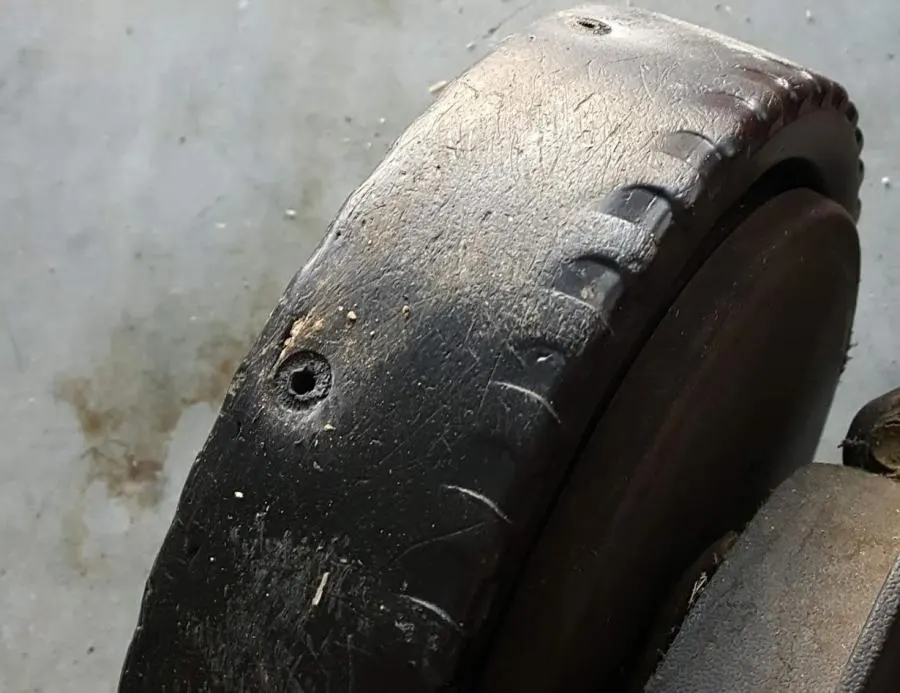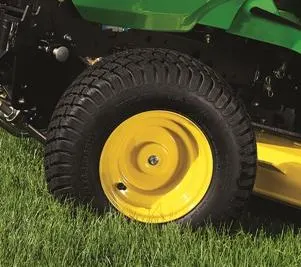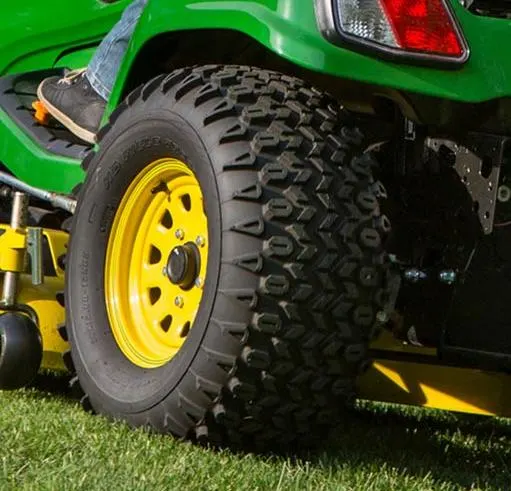Lawnmowers are here to stay, even in the unforeseeable future. Whether you have a walk-behind or riding lawnmower, cutting grass to a desirable height helps keep homesteads tidy and attractive. However, such is a feat that is only possible with well-maintained components/parts. You can choose to replace worn-out parts such as tires, belts, and blades at home or contact a lawnmower service provider for help. The most important thing is that your machine should be in great working condition so that as soon as spring or summer sets in, you are ready and set to mow. In this post, we answer the question:
How long do lawnmower tires last?
A good lawnmower tire should last at least up to 5 years, depending on the usage. The lifespan of tires depends mainly on the material, usage, and mileage. If you use your lawnmower a lot, or the terrain is hard for your tires, the life span will be shorter. You can expect a longer tire life when you use rubber tires instead of plastic ones.

According to several sources featuring opinions of top lawnmower service providers and manufacturers, treating a lawnmower as a vital home investment improves its stead and functionality. As a result, tires would also last longer while serving you better. According to J.D Power and Associates-a renowned marketing company, the lifespan of mowers ranges between 7 to 10 years. However, that could be higher for robotic lawnmowers. Maintenance and brand considerations remain pivotal in ensuring the longevity of tires. If you are a homesteader or a handyman, we know how much interest you want to vest in this topic. Unlike mower blades, investing in excellent tires is costlier. Keep reading to learn more.
Contents
Signs to Replace Tires in Lawnmowers
Let’s face it. There is nothing like repair with a tire burst unless you take it back to the factory for recycling. Then, you can whet blunt lawnmower blades or even clean clogged gas filters. However, with tires, the approach to maintenance is different. You can take precautions that will help prevent dry rot, but there is only one way about it when age catches up with tires. It is always that time you replaced old worn-out tires with brand new ones.
Of course, you should expect new tires to have a good tread for good traction on the surface, but that’s a story for another day. We will look at factors to consider when buying tires later on; meanwhile, the following signs should get you shopping for spare tires:
● Dry Rot
Most people think that dry rot only takes place in wood but that’s not the case. It is something you can also spot in lawnmower tires. Whether you use push or riding mowers, check them regularly for signs of dry rot. Cracks on the sidewall are often the main signs of dry rot, especially after many years of use. Take note that ignoring signs of dry rot puts your machine at risk of damage. You risk a tire burst or tires falling apart. Most importantly, your mower becomes very unreliable as soon as dry rot occurs because tires will start leaking air out.
Also, think about a situation where you are mowing lawns at high speed then a dry rot causes a sudden tire burst. If that happens, you could end up rolling down a steep lawn with the machine tumbling in tow. The rest would be a story for another day. However, most tire bursts will only render your mower immobile until you install new tires.
Now, before we move on to the next sign of worn-out tires, you may be asking this question: Can you protect tires from dry rot? The answer is yes. Because regular check-up is not enough, you should do the following to minimize incidences of dry rot:
- Maintain the right pressure: Always maintain tire pressure at optimal psi. It is important because when tires lose pressure, sidewalls crease and bend. In addition, bends and creases increase the chances of dry-rotting.
- Clean it appropriately: When washing your lawnmower, always use appropriate cleaners and rinse it with clean water. Avoid using harsh chemicals because they also cause dry rot.
- Avoid letting it sit for long: Leaving your mower sitting around for years increases the chances of dry rot. In addition, tires lose tread hence the risk of rotting. The catch here is that you should always replace tires with low treads with new ones.
- Protect from sunlight: Direct sunlight causes dry rot. Thus, you should always store your lawnmower in a garage or a shed.
● Mower is wobbling
Another sign of worn-out tires shows up when a lawnmower starts wobbling. While mowers should wobble a little because it is a design specification, too much of it should sound an alarm. When you compare wobbling tires and a bad haircut, you realize there is a bigger problem than it seems when it has to do with lawnmowers.
If it is not a loose axle nut causing the wobble, the chances are high that uneven tire tread is the problem. You should, therefore, replace worn-out tires immediately. Sometimes problematic wheels can be the reason for wobbling. Thus, always conduct a rigorous check to rule out such a possibility before buying new replacement tires.
● Dead tread
Signs of dead tire tread lack traction, especially on wet surface/grass, and poor traction on a dry surface. To determine whether your tires are good or bad, inset a coin into the groove or use a tread gauge. It is something you should do regularly before deciding whether to buy new tires or not. Also, the dead tread is likely to cause dry rot. But that’s something different. Causes of dead tire tread are things we also wanted to help you explore. They include:
- Prolonged use: This is the main cause of dead tread. It is expected that after many years of use and mileage, treads become shallow, signaling reduced performance.
- Insufficient inflation: Another cause of tread wear is improper inflation of pressure. You will begin to notice tires losing their tread unevenly, something that is often unsightly. The catch here is that you should always ensure optimal inflation and distribution of pressure for even the spread of load. It also ensures an even and proper contact patch.
- Misalignment of the tires: Improper tire alignment is another major cause of tread wear. When tires are properly aligned, adjusting their angles and contact patch accordingly, they retain tread for long.
The danger with shallow tread is that your mower will lose traction and become slow. You don’t want to risk mowing grass in snowy or wet conditions with worn-out treads lest you risk a dangerous skid.
● Tires that lose pressure fast
Do you fill the tires often with pressure? Do you spend several minutes refilling pressure? If the answer to these questions is yes, then chances are high that tires on your lawnmower have a hole(s). You should, therefore, consider patching them up using a tire sealant or buy replacement tires. The catch here is that while is it is natural that tires lose some pressure when riding or pushing mowers, many homesteaders say they go for a year without having to pump more pressure.
How to make lawnmower tires last longer?
The next question you would probably ask is how then can one make lawnmower tires last longer? Well, we did some homework on that too and found out that to make your tires durable, you should do the following:
● Buy original tires
You should not expect tires on your lawnmower to last long if you don’t buy original ones. So, you may want to ask further, how does one know he or she is putting money on the best tires? Well, whether you choose to go for Kenda Turf tire brands or Carlisle Turf lawn tires, quality products from reputed manufacturers will never disappoint.
● Proper storage
Another way of ensuring tires on your lawn mower last longer is by storing them properly. Of course, you are not going to remove them every time you park your machine. Rather, if you don’t have a motor garage in your backyard or house, we advise constructing a shade specifically for keeping your lawnmower. We indicated earlier that tires are likely to dry rot when exposed to direct sunlight, so always ensure they are in a cool shade.

● Proper maintenance matters
For machines to serve their purpose for long, proper care and maintenance are important. Thus, when it comes to ensuring the longevity of lawnmower tires, you should always check them for wear and tear. But here is the catch. If it is not replacing worn-out tires, is it possible to maintain them? Well, tire maintenance is possible. First off, you must ensure they always have ideal pressure and are properly aligned to avoid uneven wear of the tread. Secondly, retreading old tires is a maintenance practice that works. We will explain how to retread tires shortly.
● Do not wash tires with harsh chemicals
Tires are made of rubber, and it means they can react with some chemicals. It is why; you should avoid using harsh chemicals when washing your lawnmower. If you don’t have access to the recommended cleaners/washing detergents, use clean water.
● Avoid overloading
You don’t want to overload your lawnmower with tools because it will affect its optimal performance. If your machine does not come with a user manual giving a specific load limit, consult its manufacturer for advice. Overloading tires reduce their life span. Even worse, it always has a negative impact on the axle, which will push the cost of lawnmower maintenance higher.
● Install matching tires
Mismatch tires on a push lawn mower will not only affect its optimal performance but also make mowing feel like pushing against a brick wall. We know that sometimes it can be difficult finding an exact match of original tires on your mower, but not entirely. Even with limited edition mower brands, having the right tire measurement should save you from the stress of having to replace worn-out tires often. In addition, matching tires means going for the same tread quality, width, diameter, and height when looking for the best spares.

You may want to ask, why is using mismatch tires a bad idea? Well, tires that do not match with the original ones dimensionally do wear out unevenly. You can only imagine how difficult it would be working with such a mower. Talk less about the possibility of a tire blowout and regular puncture.
● Keep tire pressure optimal
Making sure tire pressure remains optimal cuts for a whole topic. But let’s make it simple for you. When tire pressure is optimal, you realize faster mowing, thanks to machine efficiency. Having enough pressure in lawnmower tires guard against uneven wear and tear, thus, if you do not know to gauge it correctly, seek help from an expert. But with most tires coming with an instructional manual as part of after-sales services, keeping pressure in your lawnmower tires optimal should not be rocket science.
● Rotate tires after some mileage
Another practice that will breathe long life into the tires of your lawnmower is rotating them after, say, 6000 miles. You can check into lawn mowing service to get help with tire rotating or do it in your home garage.
● Regular tire inspection help keep them in good shape
Tire inspection may sound obvious but very crucial. If you hardly check tires on your lawnmower tires for dry rot or tread wear, you could end spending unnecessarily on a new set. When inspecting these vital components of your mower, look out for cracks, sharp objects, pressure levels, bulges, stones, glass, screws, and nails.
You don’t want to ignore the possibility of these objects getting attached to the tires in the cause of mowing and risk unprecedented blowout or puncture. Therefore, you should conduct a rigorous check before mowing to ascertain the machine is safe for use and afterward before storing your mower. It is a proven way of prolonging tire lifespan.
Tire Retreading-Does it help and how should you do it?
Did you know you can retread tires of your lawnmower to improve their quality of grip? Yes, tire retreading is and should be part and parcel of care and maintenance. It may not be an easy task, especially for those who think it is a tedious process, but it’s worth giving a try. Retreading tires will make them look as good as new, and that means easy mowing all the way.
For those reading about retreading mower tires for the first time, it is not rocket science. You need a few tools and items to do it right. A string, 0.5-inch screws, screwdriver, string, and scissors/snips are all you need to get started retreading. The process of retreading involves the following:
- Measure the circumference: Use the string to measure the tire circumference. You should do it first with rear tires off the ground.
- Cut off to the right size: Now, using scissors, cut off bicycle tires the size of your lawnmower’s tires. In the same way, cut treads on the bicycle tires so that they are a perfect fit as those on the mower’s tires.
- Drive the screws: Get the screws and drive them through the end of the treads you removed from the bike. Screw them tightly all around. You can use two or three screws to make the treads tighter.
- Repeat: Repeat the above process for the other tires. You are now free to start using your lawnmower with an assurance that the treads will have a firmer grip on the lawn, giving you more control and convenience.

You should, however, note that retreading tires is only a short-lived way of prolonging their lifespan. Professional tire maintenance demands that you replace worn-out tires as soon as tread loses traction. While retreading might help, therein is a danger of poking holes into tires.
Final Thoughts
In the end, how long tires on your lawnmower last depends on maintenance and care. You may have suffered a tire blowout a few times, but the question is what caused it. The catch is that while this post has walked you through the nattiest and grittiest of lawnmower tires, especially how to make them last long, everyone is a culprit of circumstance. After many years of service, mowers begin to experience wear and tear. If it is not the blades, then tires will be slowly losing traction.
Moreover, remember that when replacing worn-out tires becomes inevitable, don’t just do it to save time. Rather, replace old tires with a new and original set. Take note that variation in tire dimension, however small, can have a negative impact on the optimal performance of your lawnmower. Thus, you should always check the product label and read the user manual to guide your purchase. If need be, consult lawnmower service providers or manufacturers for professional tire care and maintenance. Nothing would put the lifespan of tires at risk, like ignorantly buying mismatching spares or thinking dry rot is a normal occurrence.

What should I do if my lawnmower tires lose pressure fast?
Keep up with regular tire maintenance to prevent pressure loss. If the issue persists, you may need to patch up holes or invest in new tires for your lawnmower.
How do I know if it is time to replace my lawnmower tires?
“Inspect your lawnmower tires for dry rot, wobbling, dead tread, or fast pressure loss. If you notice any, it’s time to replace them for better performance and safety.”
What is the recommended tire pressure for lawnmowers?
The recommended tire pressure for lawnmowers is about 10-14 psi. Be sure to check your specific model’s manual for the most accurate information. Thanks for reading!
Are there specific brands of lawnmower tires that are more durable?
We recommend choosing durable brands like Kenda Turf or Carlisle Turf for longer-lasting lawnmower tires. Proper maintenance, storage, and care are also vital in extending tire lifespan.
How can I tell if my lawnmower tires have dry rot?
“Inspect your lawnmower tires regularly for cracks or dry rot signs. Cracked sidewalls indicate dry rot. Replace worn-out tires promptly to prevent mower damage. Safety first!”
Can washing lawnmower tires with harsh chemicals damage them?
Hi Russell, washing lawnmower tires with harsh chemicals can damage them. Stick to using clean water or recommended cleaners to avoid dry rot and potential risks to your mower.
Is there a specific time frame for rotating lawnmower tires?
Thank you for your inquiry, Jerome. It is recommended to rotate lawnmower tires after approximately 6000 miles for optimal performance and longevity.
Is retreading lawnmower tires a common practice?
“Retreading lawnmower tires can help improve traction and longevity, but it’s not a long-term solution. Consider replacing tires with new, original ones for optimal performance and safety. Thanks for your question!”
Should I store my lawnmower in a garage to protect the tires?
Hi Clarence, storing your lawnmower in a garage will indeed help protect the tires. It’s a good way to prevent dry rot and extend the lifespan of your tires. Thanks for the question!
How can I protect my lawnmower tires from dry rot?
To protect lawnmower tires from dry rot, maintain proper tire pressure, clean them with care, avoid prolonged exposure to sunlight, and store them in a cool shade. Regularly check for signs of wear. Good luck!
What are the consequences of ignoring signs of dry rot in lawnmower tires?
Thank you for your insightful question, Freddie. Ignoring signs of dry rot in lawnmower tires can lead to tire bursts and a dangerous situation while mowing. It’s crucial to replace worn-out tires promptly to ensure safe and efficient operation.